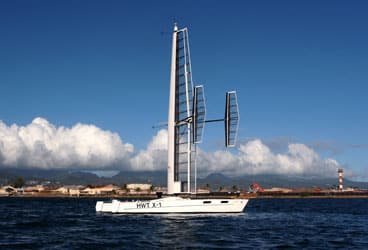
Wing sails
At first blush, I’d have thought that Mark Ott would be crazy about sailing. A born tinkerer who hails from Hawai’i, he cut his teeth on Hobie and Nacra cats, taking these little beach craft out into the wild and wave-churned channels between the islands to delight and scare the bejeezus out of himself and crew.
Hoping to double the fun on a more stable platform, he then built a 30-foot by 30-foot tri, sparing no expense on high-end sails and gear to ensure that the boat would be both powerful and fast. Though it was, it turns out that he’d only accomplished half of what he set out to do. The bigger platform—and all the forces at work upon it—really only meant that he was now able to scare the bejeezus out of a larger crew. And in that realization, a seed was planted.
“I’ve taken the sailor out of sailing,” Mark said with some satisfaction during a visit to Newport, Rhode Island, where he stopped to introduce us to his 7-year-old company, Harbor Wing Technologies. “I’ve turned sails into a wind engine.” And this engine, driven as much by software as by the wind itself, means that a skipper doesn’t “need to know a plugged nickel’s worth of seamanship to get a boat from A to B.” In fact, the boat doesn’t really even need a skipper.
This mission, if you will, really dates back to the 1990s, when Mark struck up conversations with a few cutting-edgers, including wing-technology pioneer David Hubbard, who, among many other cool things, created the wing that helped Dennis Conner win back the America’s Cup. Soon, these guys were talking to Dr. Sam Bradfield, an engineer who’d helped to twice set world speed records with his hydrofoil technology. They had an intriguing idea: use the hydrofoils that lift a record-setting multihull up out of the water to instead keep a large wing-powered vessel in the water and stable across a wide range of conditions.
As the team and plans evolved, one problem loomed large, says Ott: where to find the money. Boatbuilders thought his ideas verged on sci-fi; the aerospace guys struck a “Been there, done that” stance. Turns out that the U.S. Navy, though, saw promise in a robot that could sail for months without fuel or crew. To date, Harbor Wing has brought in about $10 million to launch one prototype and develop a second. The X-1 was built using the hulls of a 30-foot Stiletto Catamaran, and it sailed during trials at 18 knots. Its wing rotates 360 degrees and can be powered up or depowered in an instant, regardless of wind strength or direction, depending upon what the sensors are telling the software. The X-2, a revamped Contour 50 tri, should hit the water in August for trials. In the meantime, Mark and his team believe there must be a boater out there in the private sector—not necessarily a sailor, mind you—who wants to enjoy the power of the wind without all the halyards, sheets, sails, and know-how that tag along with it.
Come to think of it, maybe that could keep some trawler-bound sailors, well, sailing.








